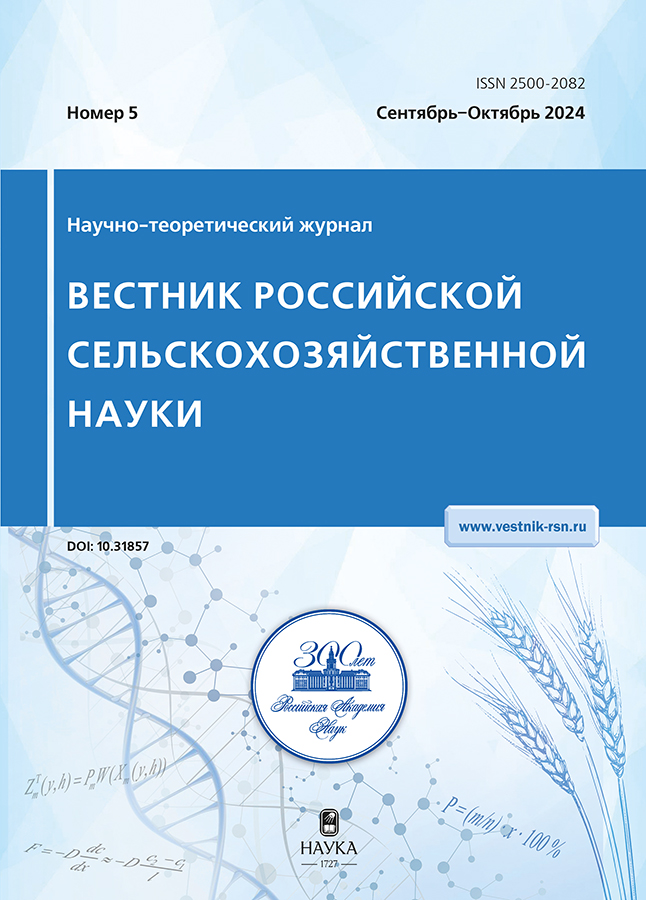Влияние минеральных удобрений и известкования на динамику эмиссии СО, урожай и качество продукции культур звена севооборота
- Авторы: Свирина В.А.1, Черногаев В.Г.1
-
Учреждения:
- Институт семеноводства и агротехнологий – филиал ФГБНУ «Федеральный научный агроинженерный центр ВИМ»
- Выпуск: № 5 (2024)
- Страницы: 45-50
- Раздел: Растениеводство и селекция
- URL: https://vietnamjournal.ru/2500-2082/article/view/659246
- DOI: https://doi.org/10.31857/S2500208224050106
- EDN: https://elibrary.ru/ztefvu
- ID: 659246
Цитировать
Полный текст
Аннотация
В полевом опыте исследовали влияние повторного внесения извести на эмиссию СО2 из почвы, урожай и качество растительной продукции с применением минеральных удобрений N90Р90К90 на темно-серой лесной тяжелосуглинистой почве. В результате известкования, улучшения кислотного режима в почве создаются предпосылки к усилению жизнедеятельности полезных микроорганизмов. Выявлено, что повышение биологической активности (эмиссия углекислого газа) на фоне минеральных удобрений N90Р90К90 и СаСО3 обеспечивает высокую урожайность и качество продукции, способствует благоприятным условиям сохранения плодородия почвы и в большей степени стимулирует развитие микроорганизмов, использующих минеральные формы нитратного азота. При систематическом применении минеральных удобрений N90Р90К90 в звене севооборота повышаются показатели качества возделываемых культур (питательная ценность зеленой массы клевера, содержание сырого протеина, белка, клейковины, крахмала в зерне ячменя, натуры зерна в озимой пшенице). В разные по погодным условиям годы получено зерно с высоким содержанием сырой клейковины, белка, натуры в зерне озимой пшеницы, крахмала в ячмене, зольных элементов питания в клевере. Наилучшим оказался вариант с использованием доломитовой муки и N90Р90К90. Все рассматриваемые показатели качества озимой пшеницы под влиянием удобрений и извести улучшались, разница с контролем составляла: белок – 0,64–1,78%; сырая клейковина – 1,6–4,3%; натура зерна – 11–26 г/л. Наибольшая продуктивность получена при внесении минеральных удобрений и извести: ячмень – 3,53 т/га, сено клевера первого года пользования – 77,53, озимая пшеница – 7,89 т/га, по сравнению с контролем без применения удобрений.
Полный текст
Об авторах
Вера Алексеевна Свирина
Институт семеноводства и агротехнологий – филиал ФГБНУ «Федеральный научный агроинженерный центр ВИМ»
Автор, ответственный за переписку.
Email: svirina-vera@mail.ru
старший научный сотрудник
Россия, с. Подвязье, Рязанская обл.Виталий Геннадьевич Черногаев
Институт семеноводства и агротехнологий – филиал ФГБНУ «Федеральный научный агроинженерный центр ВИМ»
Email: svirina-vera@mail.ru
младший научный сотрудник
Россия, с. Подвязье, Рязанская обл.Список литературы
- Ахметзянов М.Р., Таланов И.П. Влияние приемов основной обработки почвы и растительной биомассы на продуктивность культур в звене севооборота // Плодородие. 2019. № 5 (110). С. 41–45. EDN: WGYZER. https://doi.org/10.25680/S19948603.2019.110.12
- Гладышева О.В., Пестряков А.М., Свирина В.А., Красников Н.Г. Известкование для улучшения плодородия темно-серой лесной почвы // Вестник Российской академии сельскохозяйственных наук. 2014. № 6. С. 26–27. EDN: SYJUWB.
- Голосной Е.В., Агеев В.В., Подколзин А.И. Влияние систем удобрений на урожайность и качество культур звена севооборота на черноземе выщелоченном Ставропольской возвышенности // Агрохимический вестник. 2013. № 2. С. 33–35. EDN: RDUQVH.
- Доспехов Г.А. Методика полевого опыта. М.: Агропромиздат. 351 с.
- Кануков З.Т., Дзанагов С.Х., Басиев А.Е. и др. Урожай и качество продукции культур севооборота при удобрении выщелоченного чернозема // Плодородие. 2009. № 4(49). С. 41–42. EDN: KYVSUV.
- Лешкенов А.М., Занилов А.Х., Крылова М.Ф. Влияние биологической активности почвы на содержание органического вещества на фоне возрастающих доз минеральных удобрений // Земледелие. 2022. № 7. С. 11-15. EDN: OZFKQO. https://doi.org/10.24412/0044-3913-2022-7-11-15
- Ломако Е.И., Алиев Ш.А. Известкование почв Республики Татарстан. Казань: ООО «Центр инновационных технологий», 2004. 272 с. EDN: XGJBFZ.
- Матюк Н.С., Полин В.Д., Шевченко В.А., Соловьев А.М. Активность микроорганизмов дерново-подзолистой почвы в различных агроэкосистемах // Плодородие. 2020. № 2(113). С. 61–64. EDN: VRPUDG.
- Минеев В.Г. и др. Практикум по агрохимии. М.: Изд. МГУ, 2001. 689 с.
- Налиухин А.Н., Власова О.А., Ерегин А.В. и др. Продуктивность полевого севооборота при различных системах удобрения и известковании // Плодородие. 2020. № 4 (115). С. 30–34. EDN: ETLXSL. https://doi.org/10.25680/S19948603.2020.115.09
- Федорова А.В., Бахвалова С.А., Демьянова-Рой Г.Б. Влияние азотных удобрений на урожайность и качество зерна озимой пшеницы // Плодородие. 2022. № 5 (128). С. 30–32. EDN UQEZFE. https://doi.org/10.25680/S19948603.2022.128.08
- Чухина О.В., Суров В.В., Токарева Н.В., Анфимова С.Л. Качество и урожайность культур звена севооборота при применении удобрений и микробиологических препаратов в Вологодской области // Плодородие. 2015. № 1 (82). С. 25–29. EDN THJMGV.
- Holland J.E., White P.J., Glendining M.J. et al. Yield responses of arable crops to liming – An evaluation of relationships between yields and soil pH from a long-term liming experiment, European Journal of Agronomy. 2019. Vol. 105. P. 176–188. https://doi.org/10.1016/j.eja.2019.02.016
- Li Y., Cui S., Chang S.X. et al. Liming effects on soil pH and crop yield depend on lime material type, application method and rate, and crop species: a global meta-analysis. J Soils Sediments 19. 2019. Р. 1393–1406. https://doi.org/10.1007/s11368-018-2120-2
Дополнительные файлы










